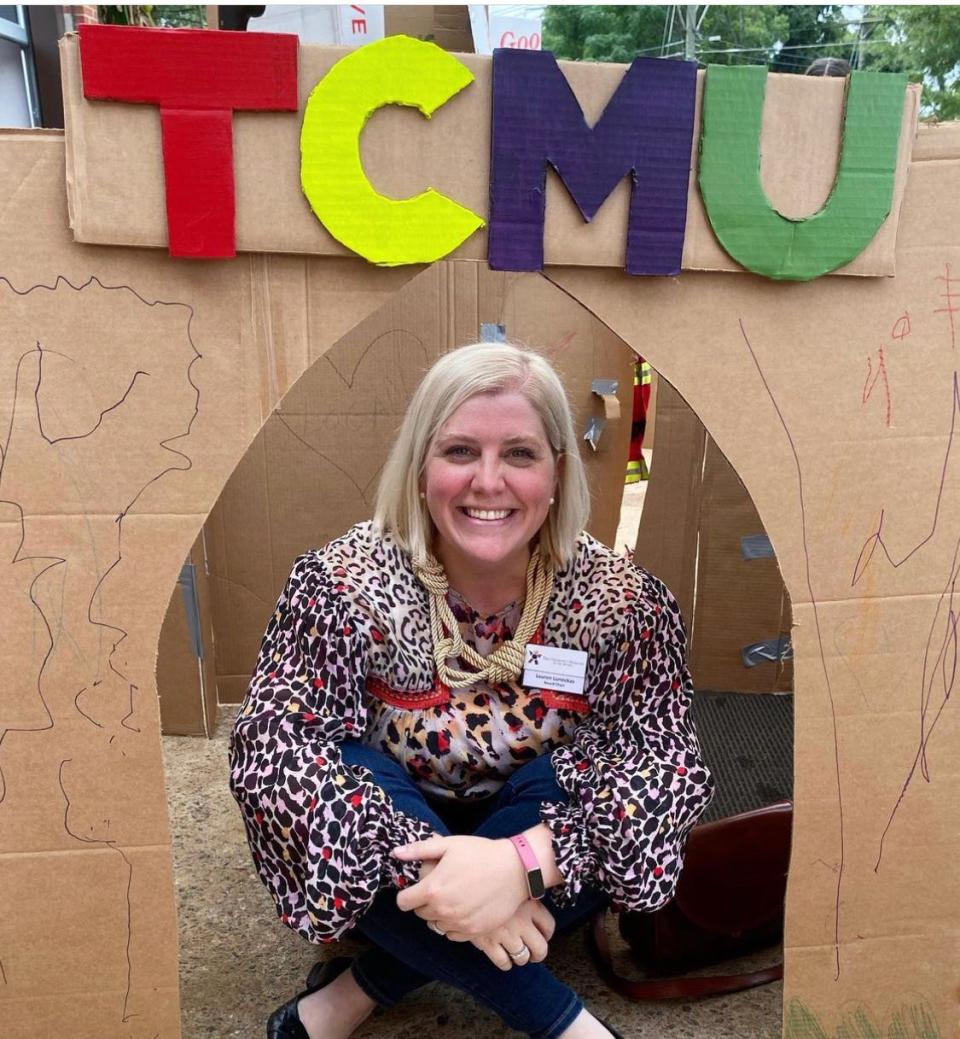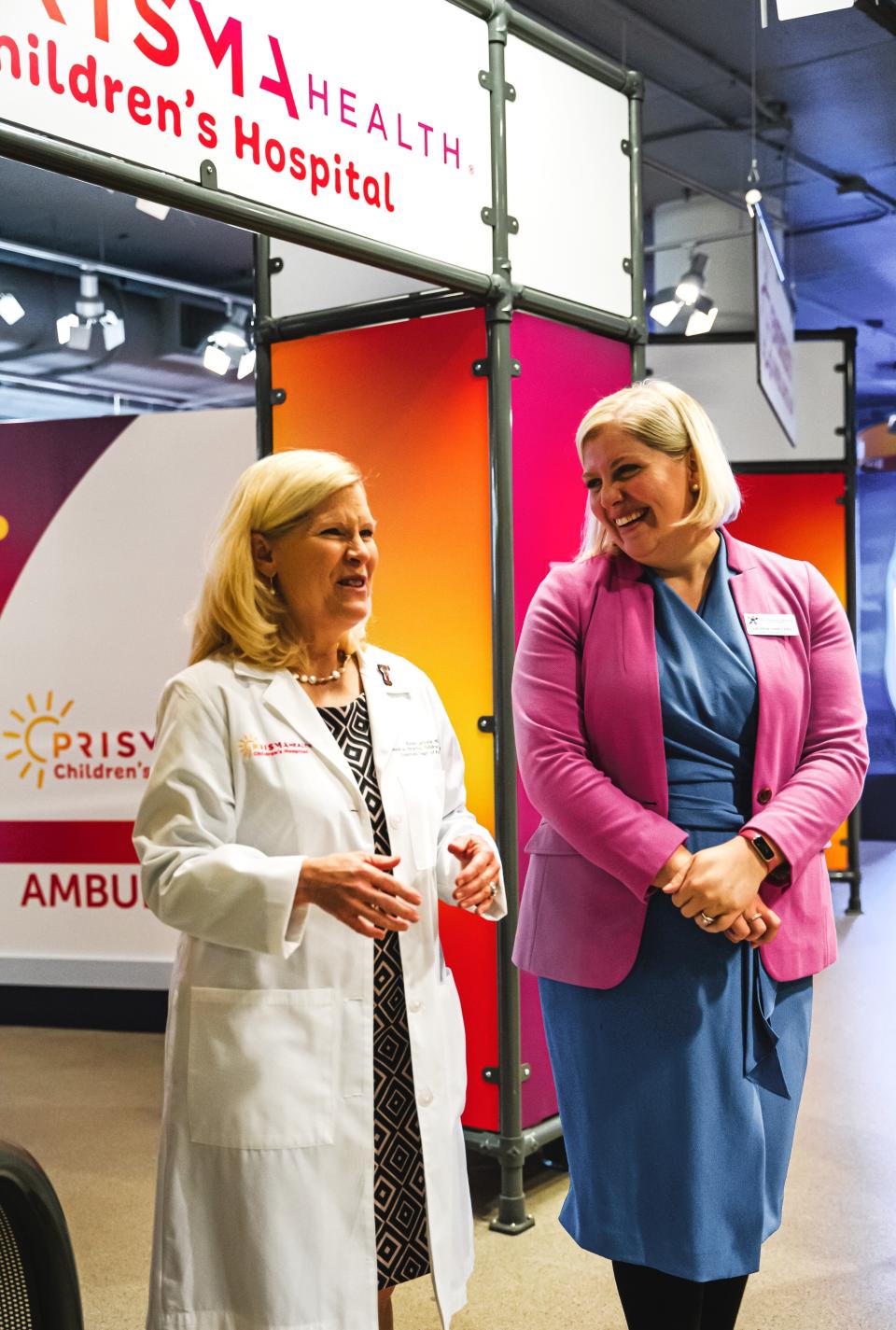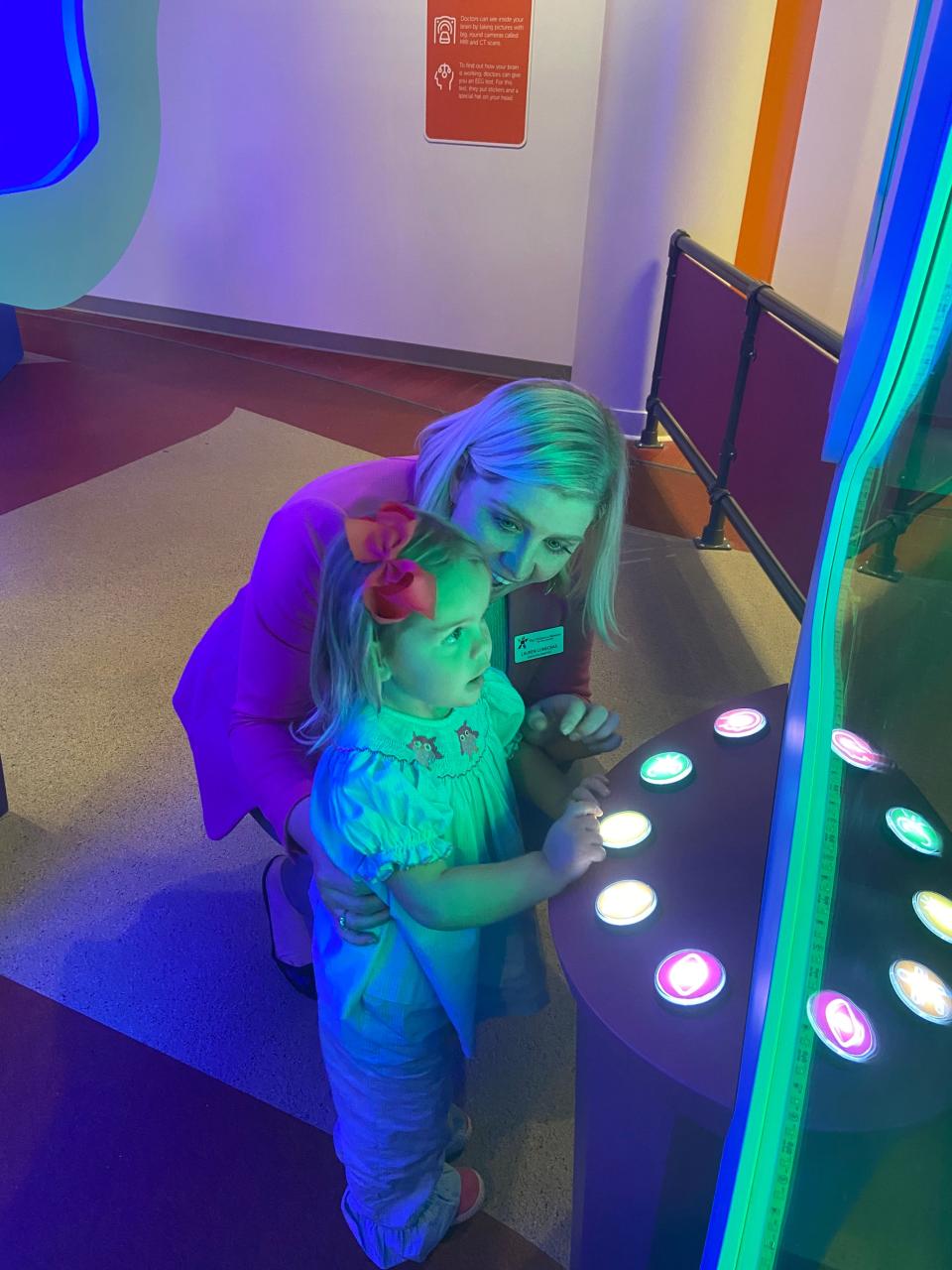15 Minutes With … Lauren Luneckas, CEO of The Children’s Museum of the Upstate
Play and wonder is a constant theme in Lauren Luneckas’ life and career.
The CEO of The Children’s Museum of the Upstate for the past two years, Luneckas moved to Greenville in 2016 to join Kentwool Performance Apparel – maker of go-to socks for golfers worldwide – as director of marketing. She was named the company’s president in 2018.
She has been active in early childhood education, volunteering in schools and with TCMU, which led to her joining the museum’s board and eventually to becoming its CEO.
Luneckas is a native of Covington, Ga., and a graduate of Wake Forest University, where she served as a student member of the university’s board and also worked for the university’s development office. She says one of her greatest memories is meeting golf legend Arnold Palmer, a Wake alumnus.
After Wake Forest, Luneckas worked in sports marketing for Bridgestone, the tire and golf equipment manufacturer. The company’s golf division is headquartered in Covington, about 30 miles east of Atlanta.

She grew up playing golf and dreaming of space exploration. Those two passions converged in 2019. A friend from Wake Forest, who worked for rocket-launch company Blue Origin, arranged for a pair of Demon Deacon-themed Kentwool socks to be sent into space aboard the Jeff Bezos-founded company’s spacecraft.
Luneckas and her husband Anthony married in 2018 and live in Greenville with their rescue dog.
TALK GREENVILLE: Thank you for taking some time to talk. We’re talking during most people’s lunch hour, so I guess a good place to start is what does a regular workday look like for you?
LAUREN LUNECKAS: It's a real perk of my job to get to have a really diverse schedule of internal meetings with our team here and external meetings with community partners and donors, board members and other folks who support us. One of my favorite parts of the role is getting to connect meaningfully with our community.
TG: When people think of the Children's Museum, often you hear things like ‘it can’t be a museum, there's no old stuff there!’ Do TCMU and other children's museums challenge the notion of what a museum is?
LL: Museum in our case is a little bit of a misnomer. Sometimes we have to educate folks about what it is that we do. “Museum” does bring up connotations of big buildings, typically government-owned that often that have historic artifacts in them. They are places where you need to be quiet, maybe places where you can't touch things. We pretty much tip that stereotype on its head. Everything in this building is meant to be interactive and hands-on and fully immersive. Creating an environment that is really vibrant and interesting; educational, of course, but also fun. And loud. We frequently hear giggles and laughter. Around museum folks, we are typically classified as an experiential museum, where most of what we traditionally think of as museums are classified as curatorial museums.
TG: Talk a little bit about coming from a non-museum background. I would think, especially for a children's museum, that might let you look at it with fresh eyes.
LL: My perspective on museums is different. I came from the corporate world and I had great experiences there and do tend to have an aptitude more towards the business side of organizations. What is really interesting is that there are far more transferable skills and activities between the not-for-profit and for-profit world. We are an organization that needs to serve a customer base, we have functions like IT and finance and HR, a staff of people who have to work together.
TG: It’s a pretty fun place to get to come to work each day, right?
LL: It is an incredibly fun place to be. There are lots of colors and sounds and it's heartwarming to be around children and families who are having great experiences and making memories together. I can pop out of my office into the museum and see exactly why it is we're doing what we're doing. In the corporate world, you're not always that directly connected to your customer. We also have an incredibly fun team. You're surrounded by creative folks in a creative environment, a very joyful environment. That is something I hope I don't ever take for granted.

TG: What’s been the biggest surprise, coming from the for-profit business world to TCMU?
LL: One of the bigger shifts for me was to embrace how collaborative nonprofits get to be. It would be almost laughable to think about calling your business competitor and saying, 'hey, what are you guys thinking of doing next spring? Or ‘hey, we're thinking about purchasing this piece of equipment, has it worked well for you?’ In the museum space, I talk to our peers across the country all the time. We are forever sharing ideas and best practices. It’s one of the very coolest parts of non-profit jobs.
TG: And you still get to include golf in your job, right?
LL: Much of my corporate career was spent in the golf industry. It's a personal passion. Now, I happen to work just a hallway away from our putt-putt exhibit, called Geo’s Golf. I love seeing the families interact in that space there. It’s a lot of fun, and there are different scientific concepts that the children can learn at each hole. That's our call as a museum, to make education fun. It’s one of my very favorite spots in the museum and brings up a lot of good memories. My dad was the one who taught me the game, so it’s nostalgic for me to see families playing together.
TG: You went to Wake Forest. There’s no shortage of love for golf there.
LL: Ties to golf certainly made my time there more fun. I managed to convince the business school that working for the golf team could satisfy my internship requirement. I helped them plan a pro-am and loved working with the team and the staff. My senior year, I met Arnold Palmer on the golf course! It was a bucket list item to meet him, period. And to get to meet him on a golf course, that is one of those memories you want to lock in forever.
TG: And golf essentially brought you to Greenville, too?
LL: Right after I graduated from Wake, I moved back to Covington to work for Bridgestone. It’s the same company that makes tires, but they also make golf balls. I worked for them for a number of years, transferred up to Tennessee to work for the tire side of Bridgestone on sports sponsorships. I did some work on Bridgestone’s Olympic sponsorship and was still connected to the PGA Tour. There was an opportunity to work at Kentwool, which was a big supplier of socks to PGA players. Mark Kent (the late president of the family-owned textile company) also went to Wake Forest and we had mutual connections. It’s a small world, the Wake world.
TG: When you joined TCMU in 2021, that was a pretty interesting time to be in any kind of hands-on business. Did the pandemic provide more challenges or more opportunities?
LL: We weathered Covid, but it was difficult, as it was for so many other organizations. We rely on philanthropic contributions like most nonprofits, but we also earn income through admissions and birthday parties and field trips. That revenue stream dried up completely. We had to close and that had an impact on our staff. It was just a very difficult and complex time. But by the time I arrived in September 2021, we had been open again for 12 months. We were open, but not everyone was ready to come back, which we totally understood. I would say that it took until the summer of 2022 to feel “normal.” One thing it did was make us all very, very grateful to have a busy and buzzing museum.

TG: Were there “silver linings?”
LL: There were things that we wanted to do to the interior of the building that just aren't really practical or sometimes not safe when there's lots of people here. We were able to do a good bit of maintenance. We reconfigured the entryway, in part to allow for better social distancing opportunities and better flow through the museum. There was a lot of time to be thoughtful and strategic about things, and in our case a lot of time to do maintenance and facilities work that really benefited from having an empty building.
TG: What's the best change that came out of it?
LL: I think being really thoughtful about the flow through the museum. That's a tangible impact, the way you move through admissions and around the building and then exit again. It was completely reconfigured, and I think in a very, very smart way. My predecessor should get a lot of credit for that. One of the things that's less tangible that happened is that it made us really engage and connect with our audience in a way that, I think it'd be fair to say, we had not before.
TG: Do you hear from a lot of adults who don’t have kids 12 and under, but want to enjoy the museum?
LL: We host adult nights -- one was at the end of September -- and we are always happy to schedule tours for those without young children wishing to see the museum. We feel very strongly about providing opportunities when we can for adults to get to experience the space. We tease that it's the only place in Greenville where you need to be chaperoned by a child. And it’s not only people who have never been in the museum. I get a kick out of the members who are here for adult night. They are frequently here with their children in the museum, but now they're here without the kids and they talk about how much fun they're having.
TG: TCMU has two locations. Talk about the differences between the museums in Greenville and in Spartanburg.
LL: It is fairly uncommon and really special to have multiple museum locations. What typically happens is that when a museum is offered the opportunity to have a second location, they either duplicate their first location or scale down what they have at the first location. When the opportunity arose (in 2018) to expand to Spartanburg, there was this really thoughtful effort to do it differently. The Spartanburg museum exclusively serves early learners, 6 and under. We got to scale everything appropriately. Our director calls it “Fun Size” and it is -- everything's just a little bit smaller, just a little bit softer, just a little bit shorter.
TG: Any plans to expand to other places in the Upstate?
LL: Many years ago, our board made a very intentional decision to name us The Children's Museum of the Upstate, not the Children's Museum of Greenville. Our mission is to serve all of the families in the 10-county Upstate region, from our two locations, but also through outreach efforts into other communities. This year we are launching two Mobile Museums, one based at each of our locations.
TG: How will that work?
LL: It allows us to take some of the programming we offer out into the community. We can't pack up the big exhibits, but we can pack up a lot of hands-on components that we use and, of course, all the knowledge of our educators travels with them. We can hit the road to go to schools and fairs and festivals and neighborhood parks. We can meet families where they are. We know that there are barriers to accessing our physical locations, like transportation and distance. So, we're excited to have the ability now to hit the road and meet families and children where they live. It’s good outreach. The Mobile Museums are bright blue vans with all kinds of pictographs on them -- dinosaurs and microscopes and other things. You cannot miss it when it is riding down the road.
TG: OK, a bit of a shift. Other than Kentwool, what drew you here? Why Greenville?
LL: When I came to interview, it was like the perfect Chamber of Commerce day in April. Birds were chirping. Main Street was bustling. The river was beautiful. I saw people out and about, folks walking downtown, and it seemed like a very relational place even just in my first minutes here. Now, I love the fact that people are so interested in supporting the community. The arts and culture scene is really dynamic. And I am not shy about how much I enjoy the dining scene.
TG: What's your favorite restaurant in town?
LL: Hands down, the Anchorage. My husband and I have lots of fond memories there. We had our wedding reception there. It was a very small wedding, and we had the reception upstairs, in the bar. We just continue to go back there. I adore the food.
More: New urban trail designed to better connect Main St. Greenville with Heritage Green museums
TG: What would your staff say about you -- what kind of boss are you?
LL: I hope they would say that I'm a real encourager and cheerleader. We have a philosophy at the museum that permeates all that we do, which is “playful, but professional.” We're not a stuffy, serious environment, but we're also not a silly place to be. We have work to do, and we want to do it well, but we get to be professional with a very playful undertone. I hope that they would describe me as “playful but professional” as well.
TG: So, much like sports is play, but it's serious. Professional golfers play a game for a living, but are very serious about their work, right?
LL: It really is necessary for human beings to play in order to thrive. For an adult that might look like golf or soccer, for children that might look like sliding down the slide on the playground, but we need to play. Even if we want to think about sports teams from an adult perspective, there are people of all different races, ethnicities, religious backgrounds, and political affiliations who will rally to cheer for Clemson on Saturday, right? It just has this unique way of bonding people and communities. I think play, what we do here inside the museum walls, has the same effect.
TG: What do you hope the museum will accomplish in the next five years or so?
LL: We want to be relevant to our community. We want to be a reliable resource for families, and we want to be a resilient organization. We're doing a lot of really good and really hard work to make sure that that's the case. Hopefully, the museum's life is very, very long, and I've just been handed the baton of leadership for this particular chapter. I want to run my leg of the race well and leave TCMU in a wonderful place for all those who will enjoy it after us.
More 15 minutes with: Chef Joe Cash, founder of Greenville bistro Scoundrel
TG: Is TCMU another one of those ways that Greenville overachieves?
LL: Definitely. We’re the seventh largest children's museum in the country currently and Greenville is not the seventh largest market in the country. For us to serve the Upstate with this type of resource -- one that many significantly larger markets don’t have the luxury of enjoying -- is tremendous. This community saw a need and made a commitment to make play-based learning accessible to every child in the Upstate. That was almost 30 years ago, and it was just exceptional vision.
This article originally appeared on Herald-Journal: 15 Minutes With … Lauren Luneckas, CEO of TCMU

